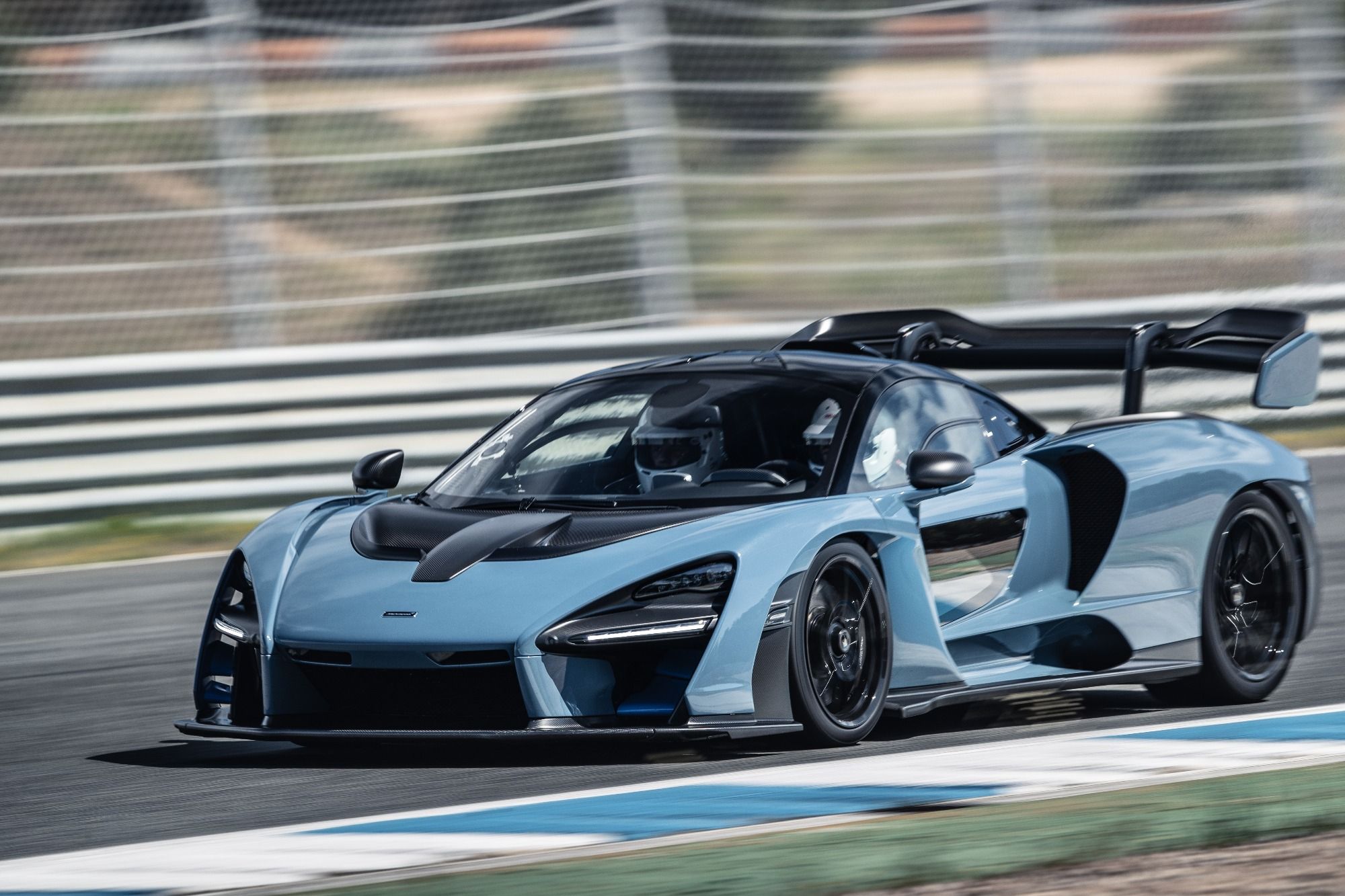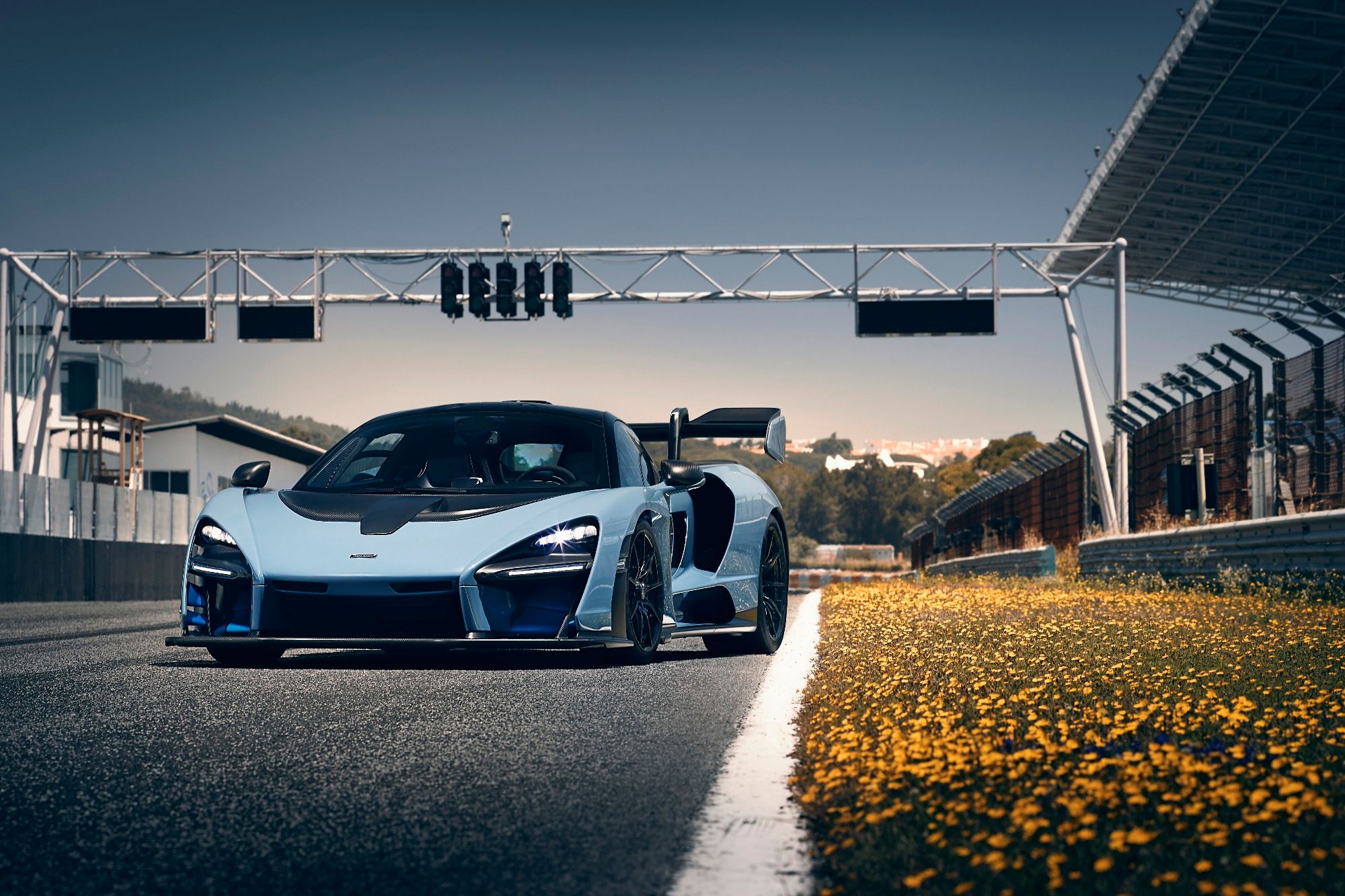
Carrying the name of the man who won three F1 World Championships for McLaren, the Senna shows that the engineers in Woking have mastered the laws of physics better than any rival at this time. The Holy Grail here is weight or the lack of it. Instead of trying to redefine the hypercar using technology like batteries and electric motors, all of which are heavy and therefore detrimental to the way the car accelerates, brakes and turns, McLaren starts from the platform of maximum possible weight reduction.
To this they then add a powerful and responsive engine, cutting edge active aerodynamics, their next generation active chassis, and top it off with the most powerful set of road car brakes known to man. It is a very simple formula really, but one aimed at total efficiency and honed to perfection. The Senna is not a direct replacement for the P1, but rather a stand alone model in its own right. There is no getting away from the fact that it is a sensational 6.0 seconds a lap faster at Estoril than the P1, which was handicapped by 440 lb of batteries and associated components. Based around a bespoke carbon-fiber central tub and clothed in carbon-fiber bodywork, the Senna tips the scales with a dry weight of 2,641 lb.
The output of the M840TR twin-turbocharged 4.0-liter flat plane crank, dry-sump V8 is 800 horsepower and 590 lb ft of torque. The seven-speed dual-clutch gearbox takes drive to the rear wheels, and shifts are as fast as can be managed by any machine thanks to the Formula 1 Ignition Cut technology that cuts the spark for a split second during a shift. With launch control enabled, McLaren claim a 0-62 mph time of 2.8 sec, 0-124 mph in 6.8 sec, with 186 mph coming up in 17.5 sec. Top speed is 211 mph, and since no racetrack has a straight long enough to let a hypercar reach 250 mph, a top speed challenge to the likes of the Bugatti Chiron was not in the brief, and certainly not the point here.
McLaren's Formula One team are world leaders in aerodynamics, so it was no stretch to imagine some of this knowledge would eventually find its way into one of the road cars in a more blatant way than we have seen up till now. The Senna's active aerodynamics produce a total of 1,764 lb of downforce at 155 mph. This is 40% more than McLaren's former flagship model, the P1 of 2014 could manage. "The advantage a road car has over a racecar that has to conform to a rulebook is that we can use active aerodynamics," Ian Howshall, McLaren's Product Manager for the Ultimate Series explained.
"Thus, while you can only use DRS in certain conditions on a racecar, you can do what you like on a road car so long as it conforms to the normal construction and use regulations. A good example of this is under braking where the sudden forward weight transfer requires a reduction in downforce over the front axle and a significant increase in downforce over the rear," Ian explained. "Our computer controlled active aero will take care of this with precisely the right amount of transfer." The mapping will also alter the downforce going into, through and out of a bend, optimizing stability and mechanical grip on the driven rear wheels.
The system will bleed off downforce gradually as a function of speed so as to not overload the suspension and tires. This is critical in places like the Döttinger Höhe at the Nürburgring-Nordscheife where the combination of aero and compression into the dip would otherwise cause the front suspension to bottom out and destabilize the car. The Senna sits on bespoke Pirelli Super Trofeo R street legal trackday rubber in 245/35ZR19 and 315/30ZR20 sizes. The big brakes you see behind the wheels use six-pot monobloc alloy calipers to clamp unique carbon ceramic discs made by a new process that takes seven months to produce one disc! In ideal conditions these brakes can stop the Senna from 124 mph in an eye popping 100 meters!
While the specification looks good on paper, the experience of the engineers and test drivers result in the magic ingredient that produces the synergy everyone talks about but is so seldom realised. The result is a fine balance that makes the Senna easy to drive if you have experience with supercars. Perhaps the most difficult thing, depending on your physical build, is getting in and out of the deeply sculpted ultra-light carbon-fiber race seats that come equipped with Sabelt six-point race harnesses. McLaren has done some ergonomic rationalization with regards switches and buttons.
By grouping most of the significant controls such as the Start/Stop button, Race mode, fan, and central locking in one section of the roof console, with the electric windows and interior and map reading lights in another, the designers have adopted proven aviation practise where finding the right button quickly is critical. Beyond that the familiar McLaren engine and transmission control mode knobs sit below the infotainment screen, while the D, N & R gearbox selector and Launch Control buttons are on a thin console that moves fore and aft with the driver's seat for consistent reach. Making a turbocharged engine as responsive as a good naturally aspirated one is an art that thankfully has been steadily advancing in recent years.
Making a 4.0-liter 800-hp twin-turbo V8 with throttle response as finely graduated as the McLaren Senna has is worthy of an engineering award. Having a sensitive and progressive throttle is one of the keys to the Senna's potential poise in corners on track. At Estoril, I quickly learned that despite the huge downforce and grippy tires I could still effectively use the throttle as a precision tool to adjust the cars attitude in corners. A classic example is in the flowing sequence at Estoril, approaching the long right hand sweeper called the Parabólica that leads from Turn 12 onto the main straight.
You exit Turn 11 in second gear and short shift to third before dabbing the brakes to carry a reasonable amount of speed over the left hand kerb of Turn 12, and accelerate moderately in a straight line towards the entry to the Parabólica. Turning in smoothly with one sweep of the steering wheel you hug the right hand curb and progressively accelerate until you feel the front end beginning to run wide. This happens because the Parabólica is not quite a perfect 180-degree curve, tightening slightly just before the mid-point of its radius. A gentle moderation of the throttle here brings the nose back into line, regains full grip at the front wheels, and allows you to meter in the power again.
With gradually increasing power you feel the Senna smoothly adopting a foursquare near neutral stance. Slowly unwinding the steering wheel while feeding in the power towards the exit curb on the left you can really feel the benefits of the active aero and suspension on the cars stability, mechanical grip, and sheer poise. During my session I also tried playing with the throttle in second gear on a couple of the slower bends. With aerodynamic downforce at its minimum here there was no question that the big rear Pirellis would be no match for the lusty motor. What I learned here was that the Senna will not chew you up and spit you out if you know what you are doing.
The characteristic velocity of the chassis is very linear, and a quick flick of opposite lock on a moderated throttle is all it takes to get the rear back in line. The Senna's soundtrack is also top notch. The mechanical melody behind your head is a heady snarl of the V8 motor and its exhaust note overlaid at some engine speeds with a hint of the gurgling noise made by a brace of carburettors. This only gets better with revs until it reaches its full crescendo at 7,500 rpm. Given the Senna's power-to-weight ratio, the gut-wrenching acceleration g-force is expected. However, the dynamic quality that impresses the most is the g-force under braking.
The very idea of mashing the brake pedal at the 200-meter marker board with 174 mph showing on the speedo is something normally associated with a full-blown GT3 racecar on slick tires. The five Senna test cars at Estoril repeated this lap after lap on street legal trackday rubber in ambient temperatures over 80 degrees Fahrenheit, with absolutely no sign of brake fade. McLaren's Senna is an all out assault on the concept of a trackday focused supercar that retains enough creature comforts to be driven to a circuit and back. Once there however, it takes sheer speed, cornering, and braking to near GT3 racecar levels with no apparent compromise. Ayrton would be proud.

